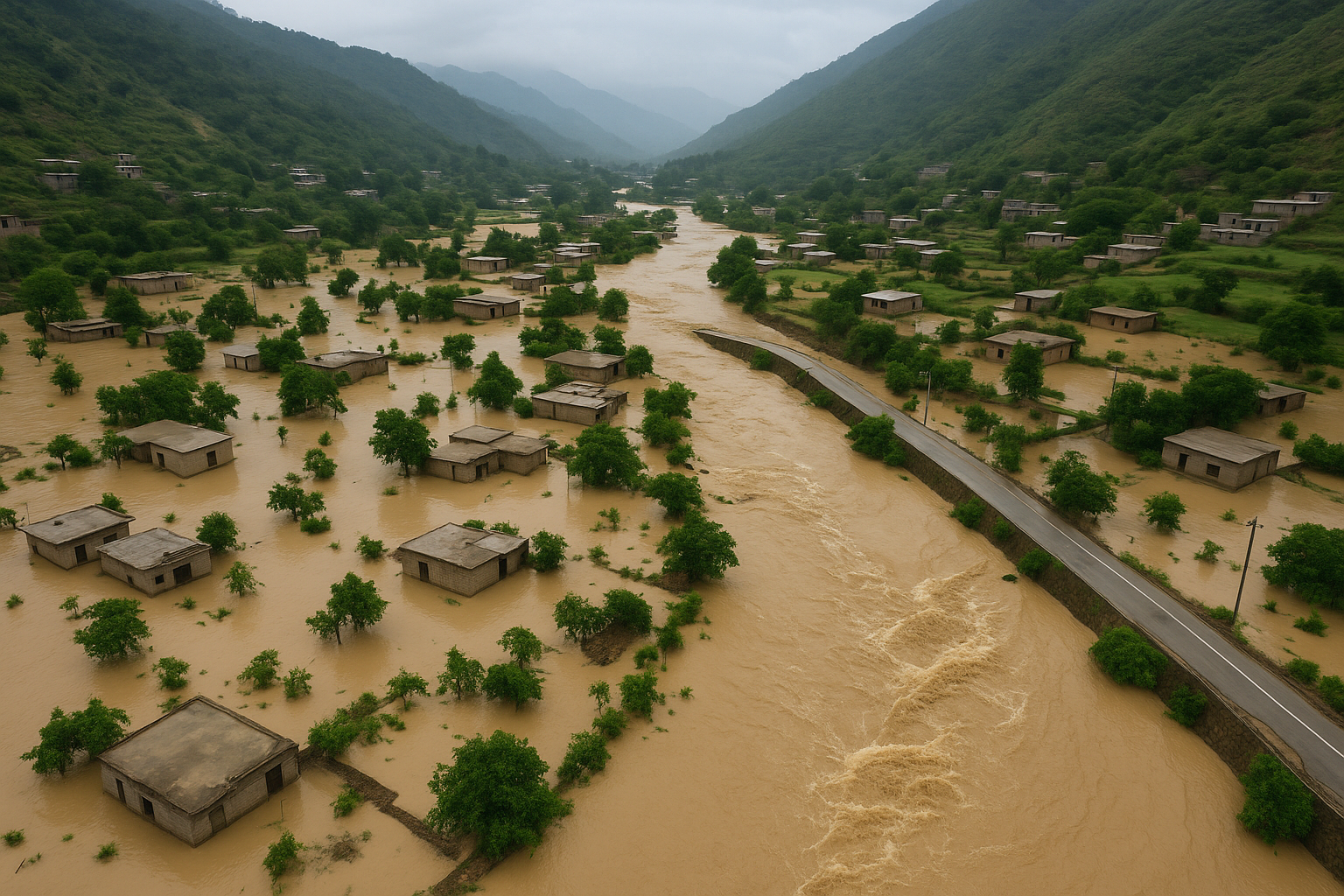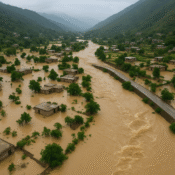
Flash Floods in Khyber Pakhtunkhwa 2025: A Disaster That Shook Pakistan
Introduction
In August 2025, Pakistan’s northwestern province of Khyber Pakhtunkhwa (KPK) was struck by catastrophic flash floods triggered by rare cloudbursts. Within hours, mountain valleys turned into torrents, villages were swallowed, and hundreds of lives were lost. The disaster exposed not only the fury of climate extremes but also the vulnerability of Pakistan’s preparedness systems.
The Trigger: Cloudbursts in the Mountains
On August 15, 2025, a violent cloudburst—an intense rainfall event where more than 100 mm of rain falls in less than an hour—hit Pir Baba in Buner District. Reports recorded up to 150 mm of rainfall in under 60 minutes, a deluge powerful enough to uproot homes, bridges, and even whole neighborhoods.
The narrow valleys of KPK, surrounded by steep deforested mountains, became natural channels funneling water and debris with destructive force. These “rain bombs” are becoming more common across South Asia as rising temperatures supercharge the monsoon cycle.
Human Toll Across KPK
The floods were swift and merciless:
- Over 200 people were killed in Buner alone. Entire families perished when mud and boulders buried houses.
- The provincial death toll exceeded 330, with victims including children, women, and the elderly.
- More than 700 lives were lost nationwide during Pakistan’s monsoon season, making 2025 one of the deadliest years in recent history.
One of the most heart-wrenching stories came from Buner, where a man returning from abroad to get married lost 24 relatives—including his mother and siblings—when their ancestral home collapsed in the floodwaters.

Buner District: Ground Zero of the Disaster
Fresh government records (as of August 25, 2025) reveal the sheer scale of devastation in Buner, the hardest-hit district of KPK:
Human Losses
- 524 people killed, including dozens of children.
- 2,991 injured, overwhelming local health systems.
- 86 still missing, feared lost in floodwaters.
Homes, Schools, and Health Facilities
- 750 houses fully destroyed and 152 partially damaged.
- 915 shops and commercial plazas damaged, paralyzing trade.
- 108 government schools and 322 health facilities reported damaged.
Agriculture & Livestock
- 19,822 acres of farmland washed away.
- 805 goats/sheep/calves and 858 cows/buffaloes lost.
For farming communities, these losses represent more than property damage—they mean long-term livelihood collapse.
Infrastructure
- 140 km of roads destroyed.
- 11 irrigation waterways ruined.
- 39 drinking water schemes damaged.
- 260 electricity poles toppled, 6 feeders disrupted.
- 3 bridges collapsed, cutting off communities.
Relief Provided
- 169 death compensation cheques issued.
- 52 shop compensation cheques distributed.
- 21,000 people served cooked meals, alongside 2,136 dry food packs.
- 1,009 tents and 2,086 non-food kits distributed.
- 70 medical camps treated 10,821 patients.
- The Prime Minister distributed 40 special cheques (Rs. 2 million each) through NDMA.
The figures show that Buner was devastated beyond recognition. Entire communities lost homes, animals, and sources of income. Relief was quick, but rebuilding will require sustained, long-term recovery efforts.
Wider Rescue and Relief Operations
The government and humanitarian agencies launched emergency responses across KPK:
- Rescue 1122, PDMA, and the Army deployed helicopters and heavy machinery.
- Supplies—tents, blankets, medicines, and food—were rushed in.
- Operations faced delays due to blocked roads, landslides, and bad weather.
- A tragic helicopter crash in Mohmand District killed five crew members engaged in relief missions.
Climate Change Connection
Experts agree: these floods were not a freak event, but a sign of climate volatility.
- Warmer air holds more moisture, intensifying cloudbursts.
- Deforestation and unplanned construction worsened damage in valleys.
- Hotels and markets built along floodplains became death traps.
Without urgent reforms in land use, ecosystem management, and climate adaptation, Pakistan risks more disasters of this scale.
Lessons Learned
The 2025 flash floods underline urgent priorities:
- Early Warning Systems – Cloudburst detection and community alerts in mountainous districts.
- Resilient Infrastructure – Flood-resistant schools, hospitals, and homes.
- Ecosystem Restoration – Reforestation and watershed management to stabilize slopes.
- Child-Centered Relief – Emergency planning that prioritizes children’s safety, education, and nutrition.
Conclusion
The 2025 KPK flash floods were more than a natural disaster—they were a climate alarm bell. The devastation in Buner shows what happens when extreme weather collides with vulnerable terrain and unprepared systems. Pakistan now faces a stark choice: invest in resilience or risk repeating this tragedy every monsoon season.


